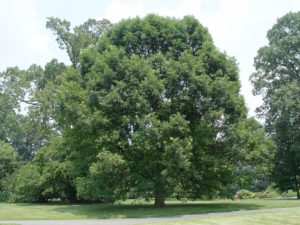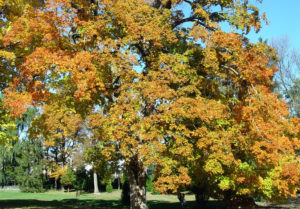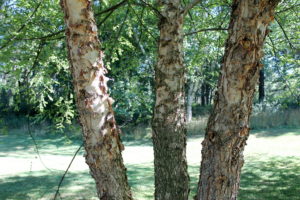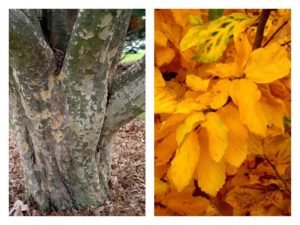10 “Climate-Smart” Trees that Can Take Our Future Heat
The U.S. Department of Agriculture’s Climate Change Resource Center says we’re on a road toward wetter, warmer, and less snowy winters; earlier springs; hotter, drier summers; more extreme fluctuations between heavy downpours and “flash droughts;” more erratic temperature swings; longer, drier autumns, and new bugs, diseases, and weeds that didn’t use to withstand our colder winters.
All of that is taking a toll on trees – particularly those that don’t adapt well to change and that don’t do well in hotter weather.
The Chicago Botanic Garden and U.S. Forest Service say the following tree species aren’t likely to fare well in the coming climate: American and Greenspire lindens, shagbark hickory, Black Hills spruce, American hop hornbeam, katsura, Norway spruce, Sargent cherry, amur maackia, Serbian spruce, beech, sugar maple, gray birch, eastern white pine, and black cherry.
Which ones are best adapted for the future? These 10 are some of the best bets in the coming heat…
1.) Autumn Blaze Freeman maple
This tough shade tree is a hybrid that combines the showiness of red maple with the durability of silver maple.
Autumn Blaze is very tolerant of heat, wind, and wet soil, and it’s adaptable to most soils (except salty) as well as urban air pollution. It’s also strong-limbed and produces very few of those “helicopter” maple seeds that some people don’t like.
It’s a fast grower to 50-60 feet tall and 30-40 feet wide in 25 years, ideally in full sun.
2.) Red maple
Arguably Pennsylvania’s best native shade tree, red maple is a fast-grower and is a good choice for occasionally wet sites since its roots can tolerate poor drainage and wet soil better than most species.
The leaves have three main lobes and emerge reddish. But the real show is fall when the leaves of the best varieties turn brilliant red. Three of the best for fall color are Redpointe, Red Sunset and October Glory.
Figure on a size of 50-60 feet tall and 30-35 feet wide in 25 years, ideally in full sun. Avoid salty sites.
3.) White oak
You won’t find any bigger, stronger, or more majestic American hardwood than this Pennsylvania-native oak.
White oak gets its name from its flaky, light gray bark (almost white). The leaves are sharply lobed and go from glossy green to russet-red in fall.
White oak also is a heavy acorn producer, which makes it one of the best choices if you’re trying to be kind to native mammals (but not such a good choice if you’re looking for a tree for next to the patio).
Its growth rate is slow to moderate, but it can eventually work its way up to 80 feet tall and wide – or more. Full sun.
4.) River birch
Another Pennsylvania native species, river birch is best known for its peeling cinnamon-colored bark and yellow-gold fall foliage. It’s a more durable choice than the bug- and disease-prone white birch.
This species prefers damp, acidy soil, so you’ll do it a favor by occasionally deep-watering in hot, dry weather.
River birch is useful to native birds and butterflies, but it can be “messy” with dropping racemes, petals, and leaves if you’re looking for something near a patio.
Don’t under-estimate how big this species can get, as many people do who plant one four feet off a house corner. River birch grows fairly fast to 40 or more feet tall with a spread of 25 to 30 feet in sun to light shade.
Dura Heat is a good variety for heat tolerance, and the 15-foot Fox Valley (‘Little King’) is a good choice if you don’t have the space for a full-sized birch.
5.) Ginkgo
This species has been around since dinosaur times, so it has a proven durability record of dealing with climate changes.
Ginkgo trees have distinctive fan-shaped leaves that turn brilliant gold in fall. They grow fairly fast to about 50 feet tall and 30 feet wide.
‘Autumn Gold’ is particularly showy and grows about 45 feet tall and 30 feet wide. If you need something narrower, look to ‘Princeton Sentry’ or Golden Colonnade.
Avoid female types (rarely sold anyway) that produce very stinky fruits. Males don’t fruit. Full sun.
6.) American hornbeam
This durable 25- to 30-footer is a mid-sized native tree with orange-red fall foliage and a smooth, gray trunk that earns it the nickname “musclewood.”
American hornbeam is slow-growing, a favorite nesting tree of hummingbirds, and its fall winged nutlets feed wildlife.
‘Fastigiata’ is a narrow form for tighter areas. Full sun to light shade.
7.) Persian parrotia
Nicknamed Persian ironwood, this is another 25- to 30-footer that’s tough, slow-growing, and offers some of the most brilliant golden fall foliage of any species.
The bark also flakes with age, giving a Dalmatian-like appearance. And it’s a tree that can be grown as a single-trunk specimen or a multi-stemmed one. Full sun to part shade.
8.) American smoketree
Gardeners are far more familiar with purple-leafed smoketrees than this native, green-leafed species that also gets the puffy, white, rounded late-spring flower heads.
Besides being a native tree, American smoketree produces glorious golden-orange fall foliage in a small, trouble-free package. Figure on 20 to 25 feet tall and wide in 25 years in full sun to light shade.
9.) Sweetbay magnolia
This small, native magnolia is both cold- and heat-tolerant in our climate and is versatile in both sun to part shade. It prefers damp soil, though.
Another plus is its fragrant white flowers in May. Sweetbay magnolia makes an excellent patio tree and grows to about 20 feet tall and almost as wide in 25 years.
10.) Serviceberry
One of the best small flowering trees, this native species has multi-season interest with its springtime white flowers, then blue June berries (that taste like blueberries and that birds love), and finally a blend of blazing fall foliage.
Serviceberries grow in sun to part shade and reach about 18 to 20 feet tall and almost as wide in 25 years.













